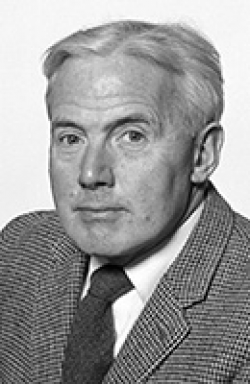Hugh Huxley

Image courtesy MRC
- Born
- 25 February 1924
- Died
- 25 July 2013 (age 89)
Hugh Huxley was a British molecular biologist who discovered the mechanism responsible for muscle contraction. The sliding filament theory that Huxley proposed in 1954 has formed the basis of our understanding of how muscles contract for the past fifty years.
Hugh Huxley was born on the 25th February 1924 in Cheshire, England. He studied physics at Christ’s College at the University of Cambridge until his work was interrupted to serve in the Second World War in 1943. Huxley joined the Royal Air Force as a radar developer. There, he worked to considerably improve the radar systems used by bomber aircraft – a feat for which he received an MBE in 1948 for 'outstanding services to the community'.
Inspired by the success of his experiments with mechanical and electrical devices during the war, Huxley decided to undertake a PhD on his return from war. He was the first PhD student of the Laboratory of Molecular Biology at the Medical Research Council (MRC) in Cambridge and used X-rays to study muscle structure.
Muscles are made of long fibres of two types of protein strands – actin (thin strands) and myosin (thick strands). After moving to Massachusetts Institute of Technology (MIT) in the United States in 1952, Huxley was able to expand his muscle research using evidence from light and electron microscopes. Working with the biophysicist Jean Hanson, Huxley proposed the 'sliding filament theory' of muscle contraction: that contraction was caused not by the shortening of muscle fibres, but by the sliding movement of actin against myosin.
It would be difficult to overstate the importance of this work. It was the first real molecular explanation for any of the complex processes that occur in the machinery of living cells. And it has held up remarkably well for more than 50 years.
Hugh Huxley
This work has been described as the ‘defining moment in the study of muscle’. Huxley, however, was intent on elaborating on his theory. In 1958 he proposed that myosin forms hook-like structures, which he called ‘cross-bridges’, that attach to actin and act like oars to drive muscle movement.
In 2004, after working with powerful X-ray sources and advanced detectors at Brandeis University in Massachusetts, Huxley was finally able to report that he had direct evidence to support the ‘cross-bridges’ theory that he had proposed fifty years earlier.
Huxley’s accomplishments were recognised both in the UK, when he was made a Fellow of the Royal Society in 1960, and in the US, where he became a member of the Foreign Associate of the National Academy of Sciences in 1978. He working productively right until his death on July 25th 2013, aged 89.



